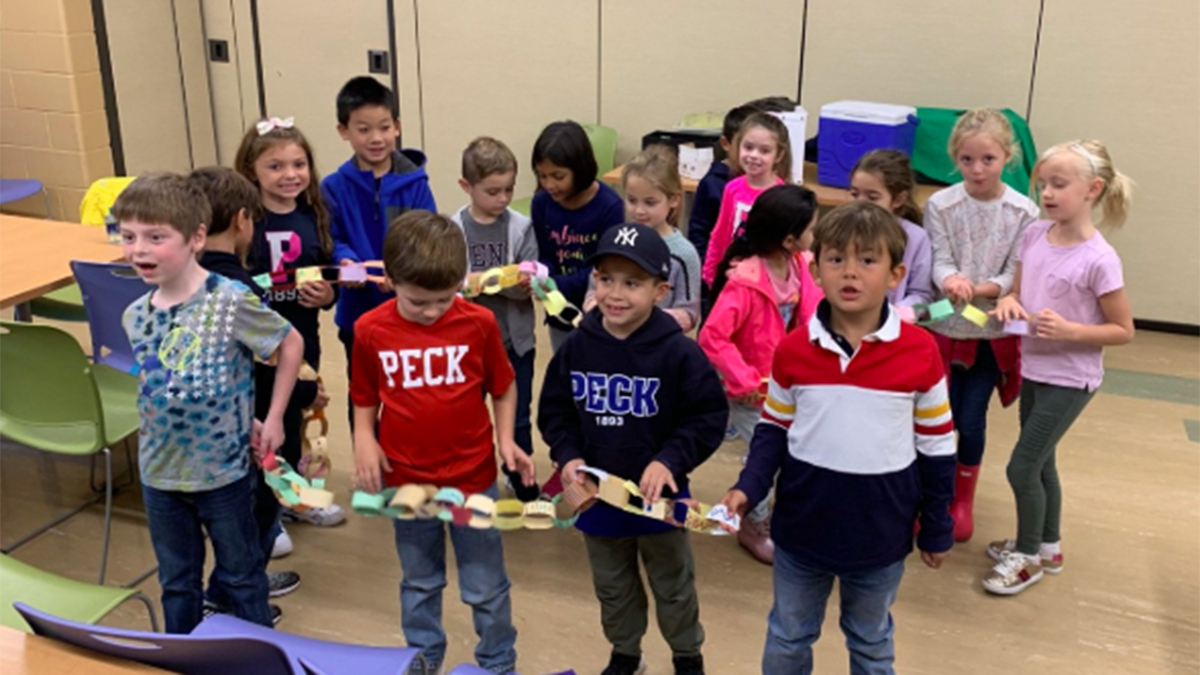feature
Enrichment for All
A visit to a zoo leads first graders to explore sound
How could we take a traditional field trip and turn it into a component of a rich learning unit? We found success in connecting our science, technology, and design class to the experiences students engaged in during a recent trip to a zoo. While students were focused on creating an enrichment toy for animals, the true enrichment was in the learning experienced by the students.
In the past this favorite trip was highlighted by the homeroom goals of understanding what makes a community and how can we take care of members of a community such as animals. Students enjoyed a fun day out that was centered on an enrichment class presented by the education center of the zoo. The trip was a stand-alone event in that it included no specific connection to the learning goals of the science, technology, and design class. With our revamped thinking on how to leverage the learning going on in the classroom, we were able to make explicit connections that extended beyond community and engaged the students with their understanding of the engineering design cycle and with the science concepts of the senses, especially sound.
Connecting to earlier studies on the five senses during the first month of school, students were ready to dive deeper into exploring sound and applying their learning through the engineering design cycle. Our first-grade students approached the trip to the zoo primed to identify how animals use their senses to understand the world around them.
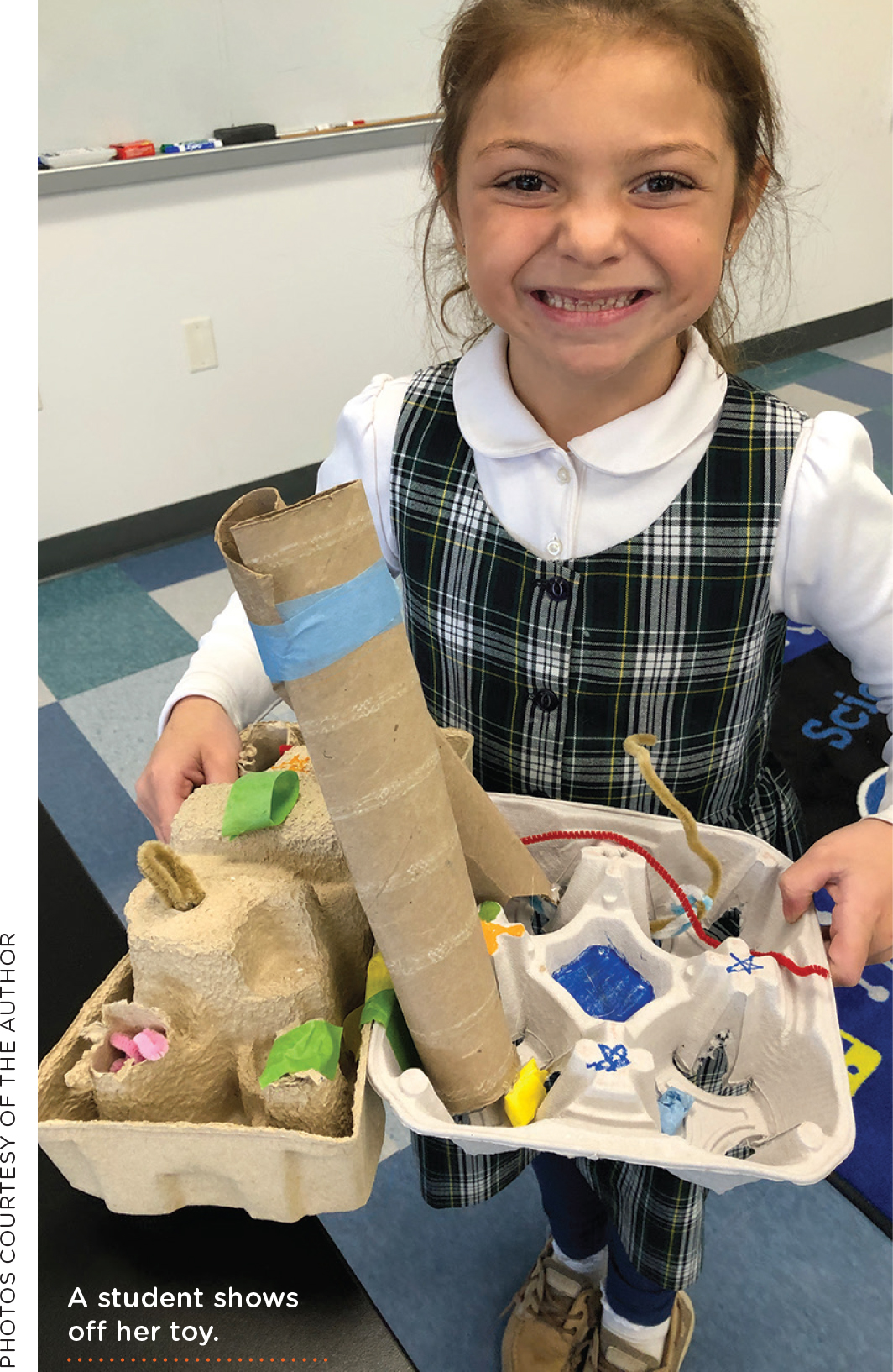
A student shows off her toy.
Focusing on Senses
Throughout the senses unit there was a focus on the learning goal of design (K-2-ETS1-2). This design challenge would to be applied through the medium of sound (1-PS4-1). As a precursor, students explored hearing with a listening walk around campus, performed a mystery sound lab, and were introduced to vibrations. Based on these experiences with sound, prior to the trip students had an understanding that vibrations cause sound and that various types of material vibrate differently. The mystery sound labs were presented in a matching game format with plastic eggs and a key of materials. The lab provided experience with varied materials such as beads, coins, cotton balls, rice, and string. This lab in particular exposed the students to the concept that different materials cause different vibrations and that you will hear them as different sounds. Mystery labs also provided experiences to better understand other senses such as smell and touch, and the engineering design process was introduced to the students with the challenge of creating a backscratcher.
Taste was not directly explored in the science lab, but discussions about snack and lunch helped students to make connections between their sense of taste and how it might deepen the understanding of their surroundings. These investigative experiences reinforced an introduction to the senses that many students had during kindergarten (K-LS1-1) and created the opportunity to integrate the design cycle into the science learning. These introductory experiences with sound and vibration as well as with the other senses were needed to make this design challenge accessible to the students.
At the Zoo
To focus student attention and optimize the learning during the field trip, we arranged for a session in the education center at the zoo. The docent from the zoo provided an engaging session focused on enrichment strategies utilized by staff to support the wellbeing of the animals. As part of the class, students were introduced to three zoo animals, including a snake, rabbit, and bird. For each animal that was presented, the docent allowed the students to see the animal up-close, then described its characteristics and explained what enrichment was provided to promote the animal’s physical or emotional wellbeing. Examples of the enrichment provided by the zoo included using recycled fire hose to create a track, puzzles to challenge an animal to get a treat, or physical challenges such as climbing stakes. Students then created a colorful paper chain to be given to the zookeeper, who would decide which animal might benefit from playing with it. The chain creation served as the culminating activity for the session at the education center. The docent led this activity by asking the students to help with the care of the animals at the zoo by creating an enrichment toy, the chain. This activity gave students a successful experience with enrichment toy design prior to their visit of the different animal exhibits.
After the enrichment class, students toured the zoo with parent chaperones and each group was asked to see if they could identify if an animal was using a sense and if there were any enrichment devices in the enclosures. In the past, this was where the experience ended, a fun time with the excitement of a day out—and students hopefully identifying examples of enrichment in the exhibits that they viewed.
To deepen the impact of the day upon the students, we changed the follow-up experiences after the field trip. Using the zoo as a source of inspiration, students went through a design cycle to create an enrichment toy for a pet that incorporated sound and one other sense. With the framework of an engineering design process to guide the lesson planning and student experiences, we created an opportunity for them to apply their understanding of the senses in a context related to the authentic examples seen in the recent field trip.
The Design Challenge
As a kickoff to the design challenge, we first explained the challenge and then had the students examine enrichment toys that were designed for babies and for dogs. These toys allowed the students to see the varied ways that sound could be incorporated into a toy design as well as how color and texture are essential elements. Teams of students working together identified components of the toy that they thought would be of interest to the animal or baby.
Small-group discussion revealed students noticed that sound varied in each of the designs and they were able to explain that the beads inside the toys were of different sizes and created sounds with differing pitches. Texture was another component that varied among the baby toys. They had both soft and rough materials that the students were able to feel. Many of the toys had parts that lit up when specific buttons were pushed. Last, students noticed that several of the toy examples had parts that moved and created a challenge to get to something interesting such as a treat.
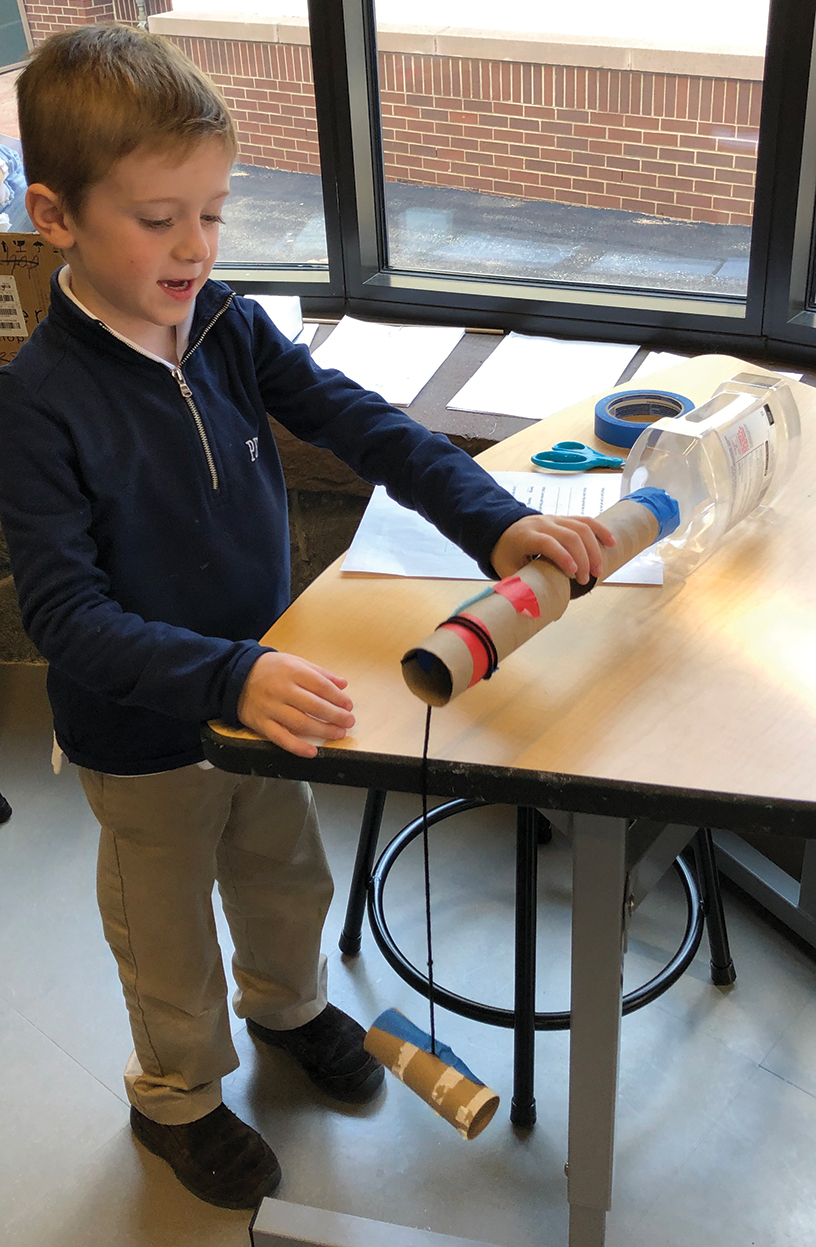
A student makes adjustments to his design.
Students then explored materials that were available for the enrichment toy design. Materials were selected with safety (NSTA 2015). When introducing the available materials, we led a discussion on what senses the material might engage. To reinforce student understanding of sound, we highlighted that different materials cause different types of vibrations and that we hear it as different sounds. A qualitative introduction to loud and soft and sounds of different pitches also allowed us to connect back to the mystery lab experience and reiterate the connection between vibration and sound. These explorations allowed the students to use their senses and begin to imagine what materials could be used to stimulate and enrich a pet through play. It is important to not provide the materials for building right away, as it will limit the creativity of the planning and lead to waste of materials by the students (Custer, Daugherty, et al. 2018). The materials included an assortment of containers, paper tubes of various lengths, pipe cleaners, cotton balls, straws, different colored tape, beans, and rice (beads are an alternative when no food policies are in effect). Those materials selected were all recycled objects to keep the cost of the project low and allow us to have each student create their own toy. Students noticed that the different materials produced different sounds, textures, and colors. They also saw that different combinations of materials could be used to integrate ideas.
Students came back on the next day of science, technology, and design class and used a planning sheet (Figure 1; see NSTA Connection for a blank template) to capture their thoughts. Each student now worked independently and identified what type of pet they were designing for and what materials they would initially need for their design. This sketching proved to be an important step in allowing the students to develop their ideas of the model they wanted to create. We had the whole group discuss the criteria for the challenge and clarify understanding of what the toy should be able to do to be successful.
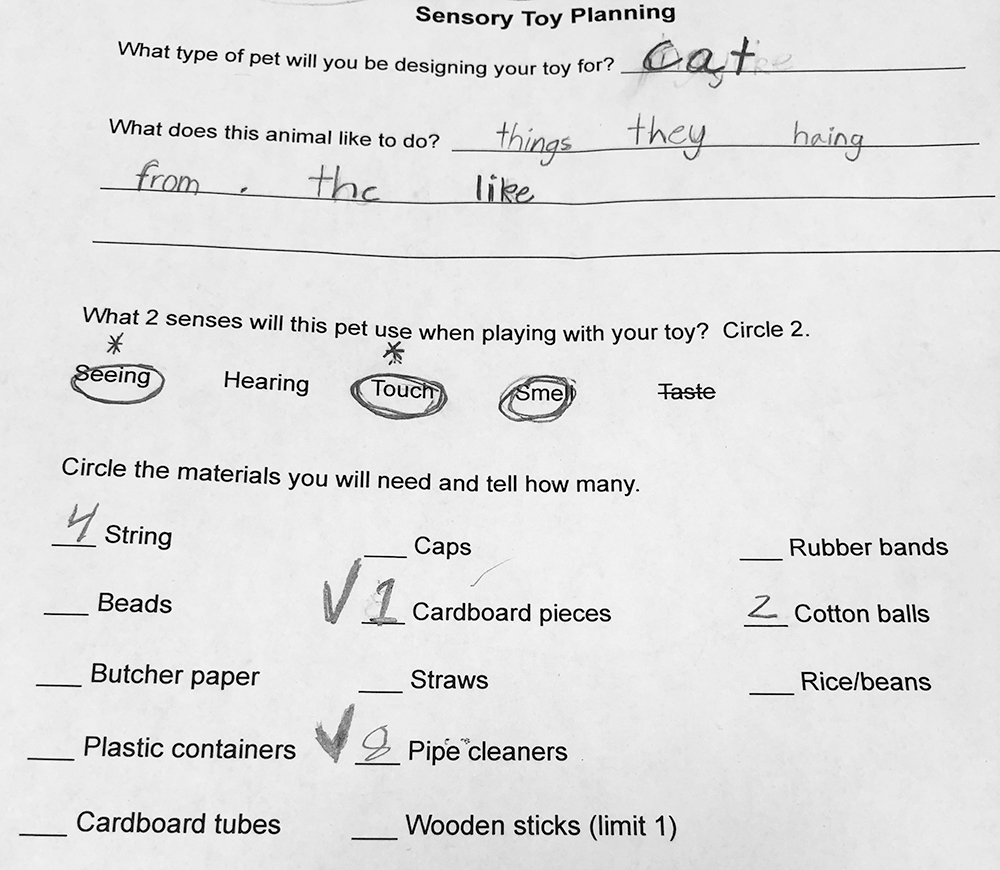
Planning sheet.
We used an engineering design process cycle of “Ask, Imagine, Plan, Create, Improve” to guide the discussions and provide the students with a visual blueprint of the process. This specific design cycle guide was selected because it is accessible to elementary students (Lottero-Perdue, Lovelidge, and Bowling 2010). We also reminded students that they had recently used the design cycle during the backscratcher design challenge. This enabled the students to recognize that this design process is an effective problem solving approach that is accessible to them to use in many and varied settings.
The students then sketched ideas of what they thought their prototype would look like and mini-conferenced with a teacher. The goal was to have the student articulate their ideas before being given the go-ahead to start building. This mini-conference session allowed us as teachers to formatively assess student understanding of the underlying science and engineering concepts and to differentiate our questioning to meet students at all levels. Teachers asked specific prompts including:
- “What animal are you building a toy for?”
- “What two senses are you using in your toy?”
- “What material will help make those senses active?”
- “How will your toy work?”
Prompts to reveal understanding of the cause and effect (Penuel and Van Horne 2018) aspects of the project include:
- “How do you know that (material selected) caused the sound?
- “How can changes to (an aspect of the design such as the container size) affect the sound?”
- “What do you predict would happen to the sound if the material was changed to (something bigger, different texture, smaller amount)?”
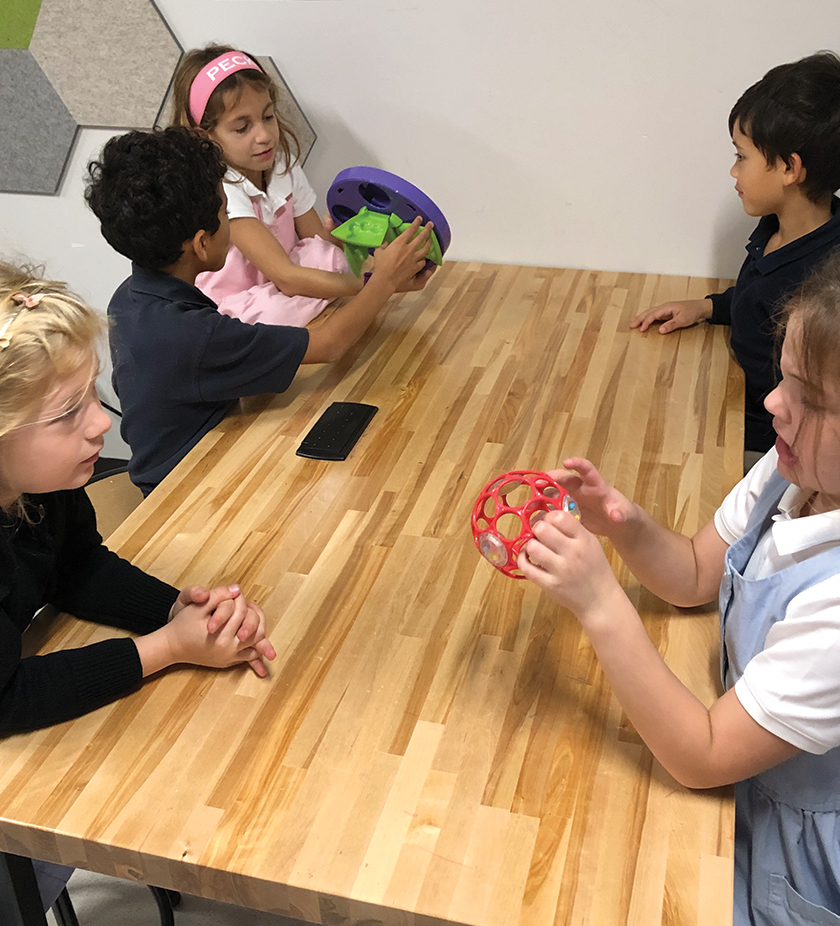
Students examine enrichment toys.
Student plans were supported through the conferences and we could differentiate if needed. Examples varied from asking students, “What if we used this material, what would happen?” to help them deepen their understanding of how sound is produced, to asking students to make connections to the volume of air involved in the movement of the vibration with a discussion of the impact of choice of different container sizes.
Students had two 40-minute class periods for the challenge including the introduction, exploration of materials, planning, building, and testing of their toy. One teacher manned a hot glue gun to maintain safety. Students altered their original designs, as revealed by their materials requests and sketches. This was expected as it is common to make adjustments when testing design improvements.
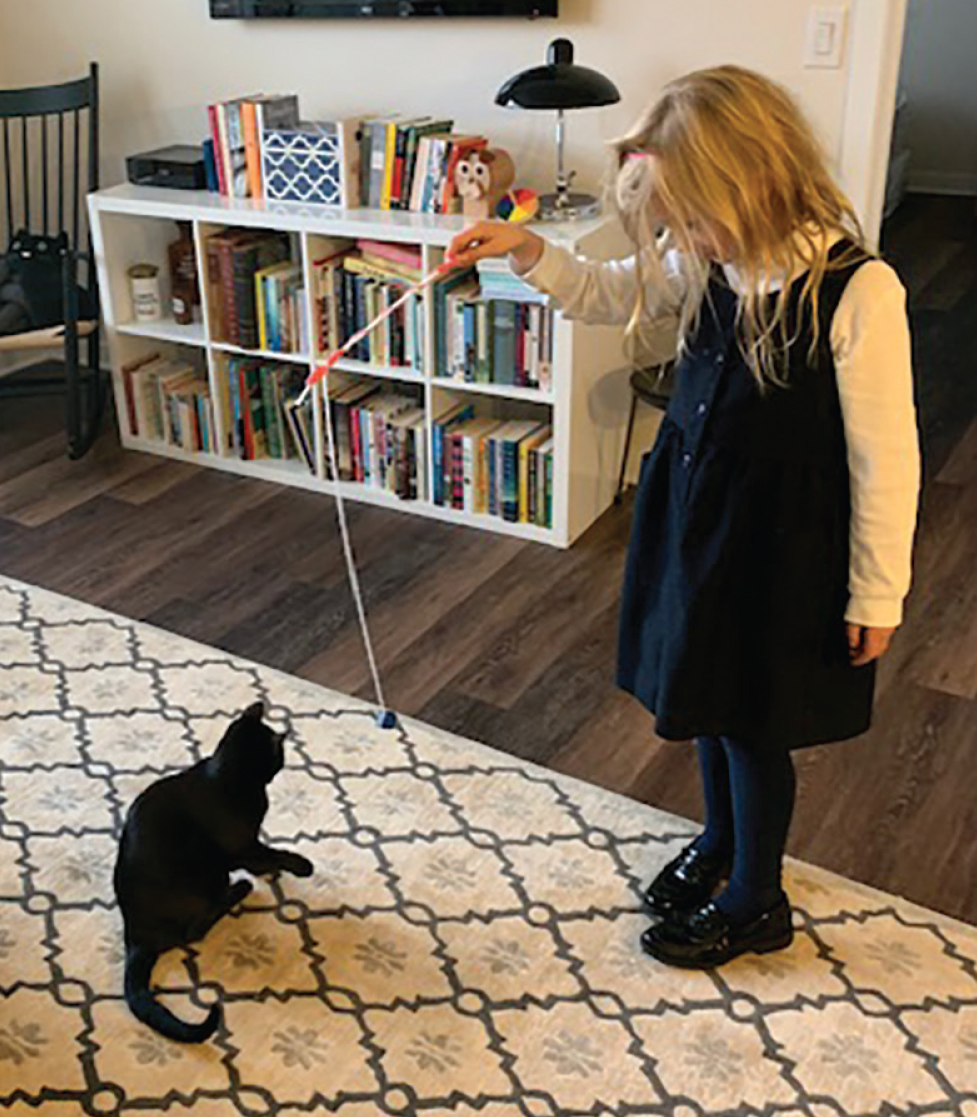
An enrichment toy in action at home.
Assessment and Presentation
Throughout the design process, teachers formatively checked student understanding through participation, documentation on their planning sheets, and through mini-conferencing. Students were able to explain why they were making particular choices for their materials and for the actual layout of the toy. We were very pleased with the students’ ability to contrast the different types of sounds that could be produced from the various materials and how students were able to connect the sound to the different vibrations that were produced.
The toys the children designed were fantastic! The prototypes were creative and varied. Animals that the students designed for included a bird, cat, dog, hermit crab, snake, and lizard—included both existing pets and ones which students thought would respond to such a toy. To bring closure to the design cycle and create an opportunity for a summative assessment by the teachers, we held a whole-class debrief. Each student presented their toy to their classmates. Prior to the presentations, we discussed the main points of focus and listed prompts that would provide guidance. The prompts served as an effective guide for the presentations of reluctant students, and it also created boundaries for students who are challenged when keeping their sharing to a smaller time period. The prompts were shared on a board for all students to see and we kicked off the presentations explaining the expectation that the students would be both presenters and audience members. The teacher prompts were not new to the students, as they were almost identical to the ones used before.
- What animal are you building a toy for?”
- What two senses are you using in your toy?
- What material will help make those senses active?
- Can you please explain how your toy works?”
Each student presented their toy design to the class and explained how it worked using the prompts as a guide. When feasible, they also demonstrated how the toy worked. To allow for differentiation to address the science behind the sound, the teachers used additional prompts. These included: “What materials are vibrating?” “What kind of sound does that produce?” “Did you test other materials? How did those sounds compare to each other?”
Overall, the assessment provided by the formative and summative activities was informed by the Next Generation Science Standards evidence statements for 1-PS4-1 and K-2-ETS1-2 (Figure 2) and served as our rubric.
Elements of evidence statements used in assessment.
1-PS4-1: Identifying the phenomena under investigation
a. Students identify and describe* the phenomenon and purpose of the investigation, which include providing evidence to answer questions about the relationship between vibrating materials and sound.
b. According to the investigation plan they develop, students collect and record observations about:
- Sounds causing materials to vibrate
- Vibrating materials causing sounds
K-2-ETS1-2
1 Components of the model
a. Students develop a representation of an object and the problem it is intended to solve. In their representation, students include the following components:
- The object.
- The function of the object.
2 Relationships
a. Students identify relationships between the components in their representation, including:
- The shape(s) of the object and the object’s function.
- The object and the problem is it designed to solve.
3 Connections
a. Students use their representation (simple sketch, drawing, or physical model) to communicate.
Conclusion
A whole-class debrief was led by the science teacher to highlight the variation in the final designs when considering that the same materials and time were available to each designer. This discussion allowed the discussion to come back to how an engineering design cycle is an important problem-solving strategy and way of thinking that allowed students to use their understanding of science to meet the challenge. Parent feedback was positive as well and communicated that pet feedback revealed that the enrichment toys were a hit!
Reflecting on the arc of the science learning, which started with the five senses and dove deep into sound, the trip to the zoo can be identified as an important component of the process. Students applied their understanding of the science of sound through the engineering design process when they created their versions of an enrichment toy inspired by the field trip. The presentations also provided a valuable opportunity for students to demonstrate their knowledge through the explanation of the design of their unique toy. This enrichment experience has proven to be one worthy of the time and truly enriching for all.
In support of our recent experience with distance learning, we must also consider how can we take a traditional field trip and turn it into a meaningful virtual experience with lessons that can be done remotely. The essential learning goals in this unit remain the same, and students can still create an enrichment toy using facilitation by the teacher through an online platform. Taking your students on a virtual field trip to the zoo is accessible to everyone and even creates more opportunities by expanding the number of zoos available to visit. Student worksheets, feedback and presentations can be facilitated through the platform used by the school. Recycled materials are still used to construct the enrichment toy; therefore students will still be able to build their design at home. This unit can be adapted to a virtual format and give educators additional lesson flexibility as virtual teaching continues.
Acknowledgment
Thank you to technology integrator Jen Garvey, who codeveloped the unit and provided valuable insight and inspiration.
NSTA Connection
Download the planning page and NGSS connections at www.nsta.org/science-and-children.
Katheryn Kennedy (kbkennedy7@gmail.com) is a Lower School Science Specialist at The Peck School in Morristown, New Jersey.
Interdisciplinary Life Science Elementary



